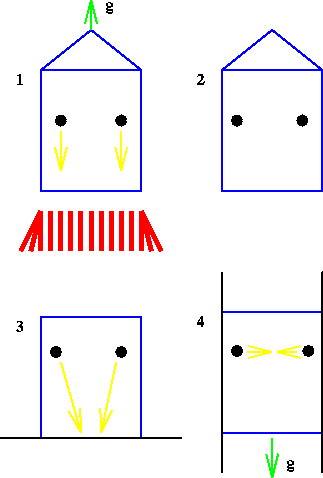
The world lines of free particles have been our probe of the possibility of constructing inertial frames. In Special Relativity two such world lines which begin parallel to each other remain parallel, no matter how far extended. This is exactly the property that straight lines have in Euclidian geometry . It is natural, therefore, to discuss the geometry of spacetime as defined by the worldlines of free particles. In these terms Minkowski space is a flat space [ it is not Euclidian space because the metric is indefinite (-+++) ]. To discuss non- uniform gravitational fields let us consider the lift experiments again, this time making them big enough so that variations of the gravitational field can be measured [ see Figure 5.7 ].
We thus conclude that gravitational spacetime is therefore not flat - it is curved. A classic example, which we will us many times to illustrate our ideas, is the surface of a sphere or balloon . Locally straight lines on a sphere extend to great circles and two great circles always intersect [ at the poles ]. Nevertheless, close to any point, we can pretend the geometry is flat. This is true also for Riemannian spaces : they all are locally flat, but the locally straight lines [ geodesics ] do not usually remain parallel.
Einsten's important advance was to see the similarity between Riemannian spaces and gravitational physics. He identified the trajectories of freely falling particles with the geodesics of a curved geometry: They are locally straight since spacetime admits local inertial frames, but globally they do not remain parallel.
